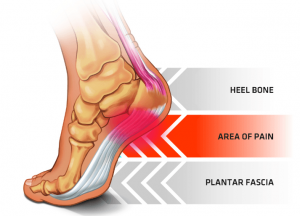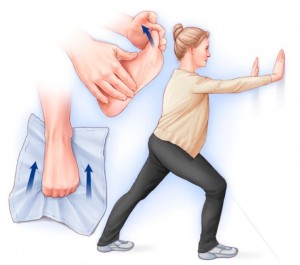Plantar fasciopathy is the inflammation of the band of tissue (the plantar fascia) that extends from the heel to the toes. The fascia first becomes irritated and then inflamed, resulting in heel pain.
CAUSES
- Overly flat or high arched feet
- Non supportive footwear (flip flops, high heels, bare feet, hard shoes)

- Increased time being on your feet (more running, walking or working on your feet)
- Obesity
SYMPTOMS
- Heel or arch pain
- Pain most noticeable with initial steps after a period of inactivity
- Pain that comes on following prolonged weight bearing
- Limited dorsiflexion (ankle flexion)
Pain can be worse upon waking up in the morning or after sitting for a long time. Pain can also reduce with walking because the fascia is being stretched with every step you take. But the pain can also return after spending a prolonged time on your feet.
TREATMENT STRATEGIES IN PHYSICAL THERAPY

- Therapeutic Exercises: stretching & strengthening of planar fascia and calf muscles
- Taping and strapping techniques
- Manual therapy: joint mobilization to increase ankle joint flexibility, deep tissue massage of plantar fascia and achilles tendon; and trigger point releases of calf muscles (Gastrocnemius and Soleus)
On your own, use proper (over the counter) foot orthotic that support the foot arch and provide heel cushioning, a night splint or a spikey foot roller. Evidence for Ultrasound, Laser and Electrical stimulation are WEAK, so don’t waste your time or money.
Symptoms can be on/off for up to 12 months which means there will be times you feel great and other times when the pain suddenly returns. You must stay diligent with managing it so it does not progress. However, if pain persists beyond 1 year, you may be referred to a podiatrist.
Haider Rizvi, PT, DPT
Board-Certified Orthopedic Clinical Specialist (OCS)
Certified Orthopedic Manual Therapist (COMT)
Certified Strength & Conditioning Specialist (CSCS)
Martin RL, Davenport TE, Reischl SF, et al. Heel pain—plantar fasciitis: revision 2014: clinical practice guidelines linked to the International Classification of Functioning, Disability, and Health from the Orthopaedic Section of the American Physical Therapy Association. J Orthop Sports Phys Ther. 2014;44:A1-A23. https://doi.org/10.2519/jospt.2014.0303
